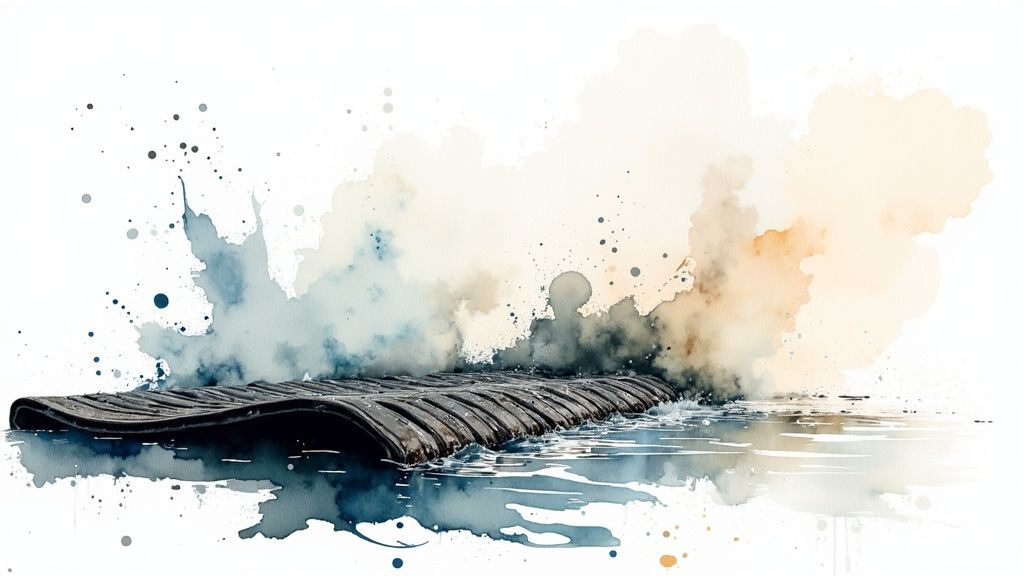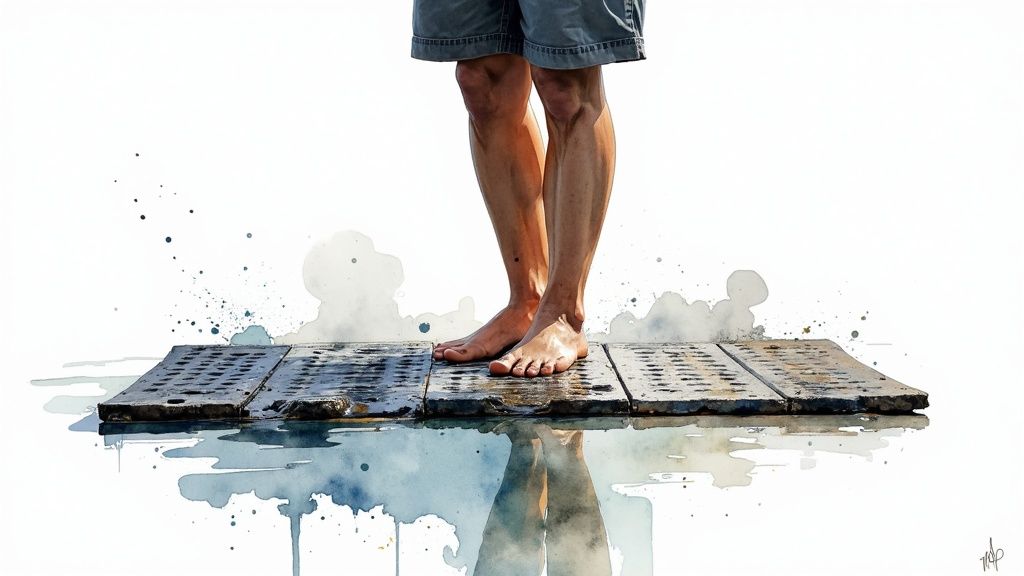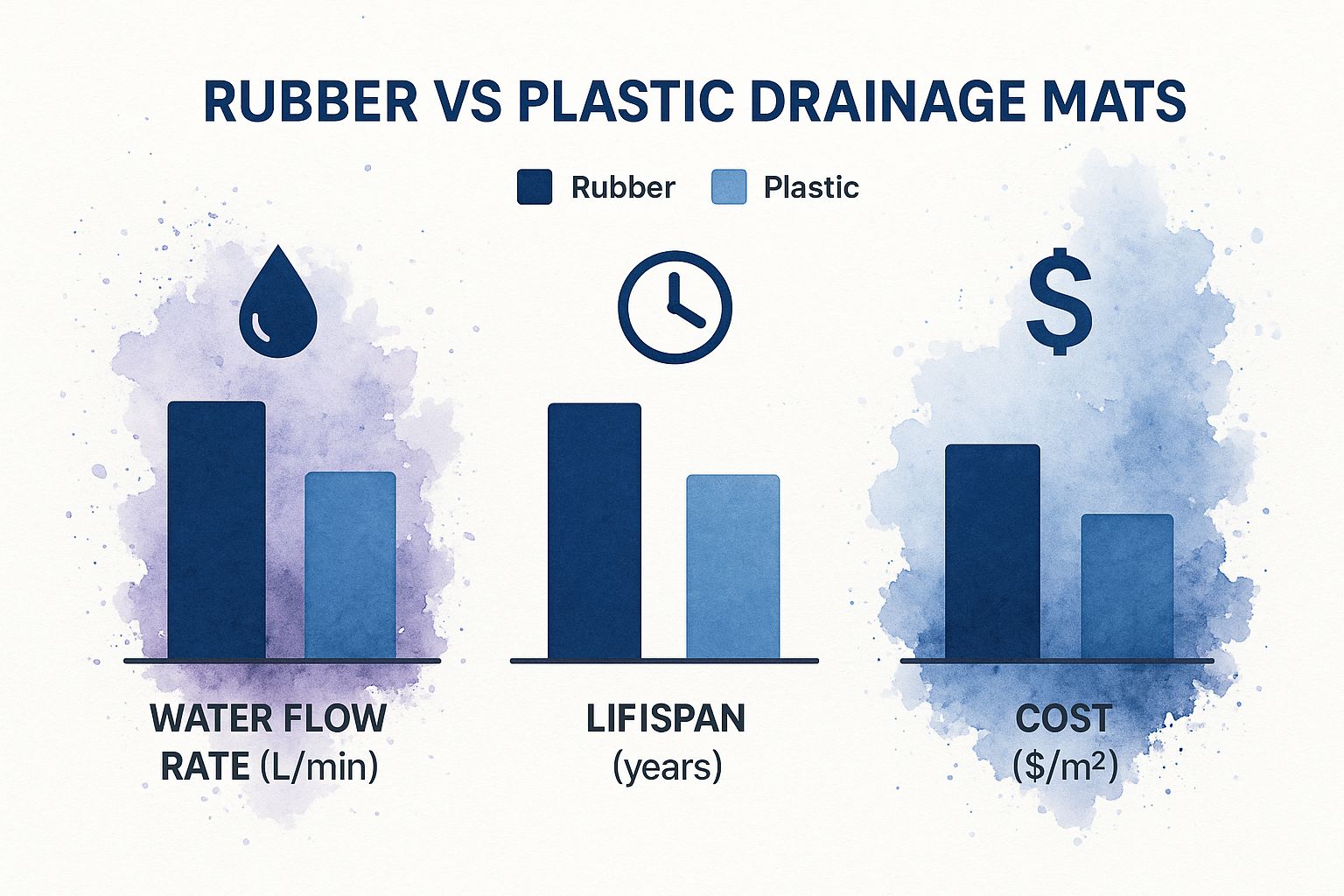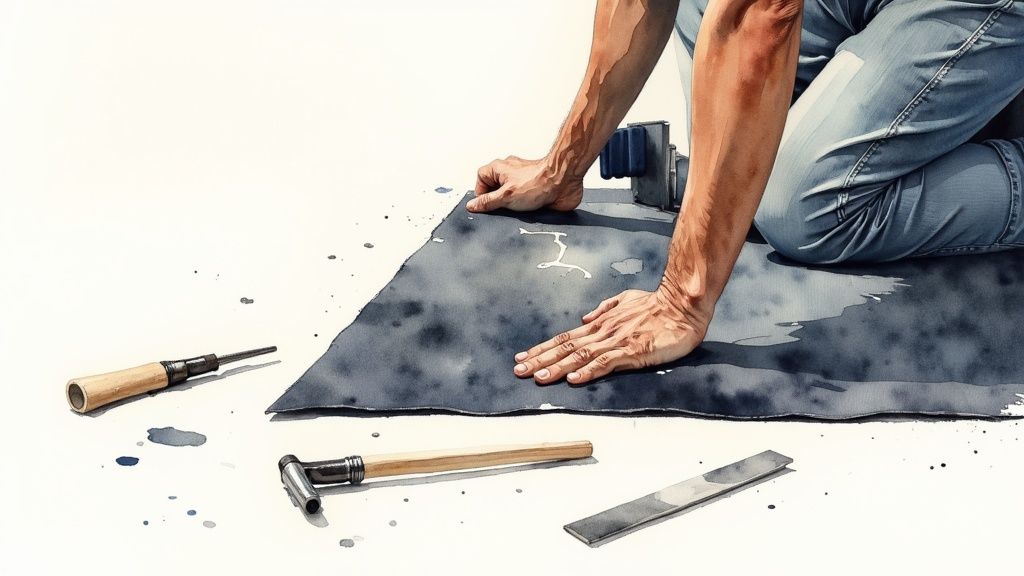Picture your busiest workspace for a moment. Is it a commercial kitchen during the chaos of dinner service? A bustling factory floor? A high-traffic bar on a Saturday night? In these environments, spills aren't just a possibility; they're a certainty. Slips and falls, however, don't have to be. This is exactly where rubber mats with drainage step in, acting as an unsung hero and an active safety system to keep your floors dry, safe, and productive.
This guide provides actionable steps to help you choose, use, and maintain the right drainage mats, transforming your workspace from a hazard zone into a model of safety and efficiency.
The Unsung Hero of Workplace Safety

Anywhere you find liquids—whether it's water, oil, chemicals, or food debris—the risk of accidents shoots up. A simple spill can quickly become a serious hazard, leading to dangerous falls, costly worker injuries, and frustrating operational downtime. Rubber mats with drainage are engineered specifically to tackle this very problem head-on, making them a critical investment, not just another piece of flooring.
These mats don't just sit there; they actively manage the hazards around them. The core of their design is simple but brilliant: they elevate your staff above the wet surface while the built-in holes and channels immediately get to work, funneling liquids away from where people are standing. It’s this immediate separation of foot from fluid that makes them so incredibly effective.
More Than Just a Safety Net: Actionable Benefits
But the impact of these mats goes far beyond just preventing slips. They play a direct role in creating a workplace that is cleaner, more comfortable, and ultimately, more efficient. Let's break down the immediate advantages you can achieve.
For a quick overview, here’s how these mats can instantly upgrade your workspace:
| Benefit | How You Can Achieve It |
|---|---|
| Enhanced Safety | By placing mats in wet areas like dish pits or machine shops, you immediately reduce slip-and-fall accidents, the leading cause of injuries in many industries. |
| Improved Cleanliness | Using mats at entrances and workstations traps dirt, debris, and liquids, stopping them from being tracked throughout your facility and cutting cleaning time. |
| Increased Comfort | Choosing anti-fatigue drainage mats provides essential cushioning to reduce strain on employees who stand for long hours, boosting morale and productivity. |
These benefits aren't just anecdotal; they're driving major market trends. The global floor mats market, which heavily features rubber mats with drainage, was valued at an impressive USD 2.28 billion in 2023. It's projected to climb to USD 5.81 billion by 2030, a surge largely fueled by a growing focus on employee health and safety in demanding industrial settings. You can dive deeper into the data on the floor mat market to see these trends for yourself.
From greasy industrial workshops to wet outdoor entryways, this straightforward solution delivers significant and tangible returns on safety and well-being.
How Drainage Mats Keep Your Team Safe and Dry
Picture a good drainage mat as a tiny, clever canal system built just for your floor. Its whole job is to get liquids out of the way, and its genius lies in a simple but powerful two-part design. This isn't just about punching a few holes in a rubber sheet; it’s a smart solution to a serious safety risk.
The real magic comes from two features working together. First, the mat has a raised surface structure. This lifts your team, your equipment, and any foot traffic just high enough to be clear of pooled liquids—whether that's water from a commercial sink, grease in a professional kitchen, or coolant on a factory floor.
At the same time, the mat is built with strategically placed holes or deep channels. These openings are the drainage pathways, whisking fluids down and away from the surface where people are standing. It’s a simple concept that stops liquids from building up, keeping the top of the mat as dry and slip-free as possible.
How to Match the Material to the Hazard
Of course, not all rubber is the same. Picking the right material is a crucial step to ensure your rubber mats drainage system works and holds up over time. The type of liquid you're dealing with will tell you exactly which material you need.
-
Natural Rubber: This is a fantastic, tough all-rounder. It's resilient, offers great traction, and is the perfect choice for areas that mainly deal with water.
- How to use it: Deploy natural rubber mats around swimming pools, in locker rooms, or at bar and dishwashing stations for reliable, water-resistant safety.
-
Nitrile Rubber: When you're up against oils, greases, chemicals, or animal fats, nitrile is the only way to go. This synthetic rubber blend is specifically made to resist these harsh substances, which would cause natural rubber to swell, curl up, and become a dangerous hazard itself.
- How to use it: In commercial kitchens or industrial workshops, a grease-proof nitrile mat is essential for maintaining safety and mat integrity.
Real-World Example: In a busy auto repair garage, a standard natural rubber mat would be destroyed pretty quickly by constant contact with motor oil and solvents. A grease-proof nitrile rubber mat, on the other hand, will keep its shape and slip-resistance, offering reliable, long-term safety for the mechanics. It’s a perfect example of how choosing the right material directly protects your team and your investment.
The growing demand for these specialized materials really shows how vital they are in today's commercial and industrial spaces. The global rubber market, which includes these essential safety products, was valued at USD 40.77 billion in 2019 and is expected to climb to USD 51.21 billion by 2027. A huge part of that growth comes from the need for dependable flooring that can manage water and keep things hygienic in expanding commercial sectors. You can discover more insights about the rubber market and its effect on safety flooring.
Getting this relationship between design and material right is the first step. To see how to put this knowledge into practice, check out our guide on how to use drainage rubber mats for unbeatable safety and efficiency.
Where Drainage Mats Make the Biggest Impact

It’s one thing to talk about how rubber mats with drainage work in theory. But where can you use them to really earn their keep? Let's move from design specs to the real world, where these mats aren't just a nice-to-have—they're often indispensable. In certain high-risk environments, they are the unsung heroes solving the daily challenges that can bring a business to a grinding halt.
Picture a busy restaurant kitchen during the dinner rush. Water splashes from the prep sinks, grease spatters from the grill, and dropped sauces create a treacherous film on the floor. It's a recipe for disaster. This is exactly where a heavy-duty drainage mat proves its worth. By placing it in these key hotspots, you can instantly create a safer, more stable surface for chefs and staff to work on. The holes catch stray food scraps while liquids drain away, dramatically cutting down on slips and making the end-of-night cleanup far less painful.
Real-World Example: The Commercial Kitchen
A popular Italian restaurant was dealing with constant near-misses around its pasta and sauce station. By installing a system of grease-proof nitrile rubber mats drainage, they saw two huge benefits. First, slip-related incidents practically disappeared overnight. Second, the anti-fatigue cushion of the mats eased the back and leg strain on the chefs, which boosted morale and kept energy levels high through long, punishing shifts.
How to Identify Industrial and Commercial Hotspots
The kitchen is just the beginning. To maximize your safety ROI, identify areas where liquids or debris are a constant issue. These are your "hotspots" where mats are critical for maintaining safety and operational flow.
Here’s a look at where they make a major difference:
- Manufacturing and Assembly Lines: On a factory floor, these mats are a first line of defense against coolant spills, oil drips, and metal shavings. They give employees a secure footing on otherwise slick surfaces and stop sharp debris from being tracked through the facility, which also saves the underlying floor from getting torn up.
- Bars and Service Areas: Anyone who has worked behind a bar knows that spilled drinks and melting ice are just part of the job. Drainage mats keep bartenders on solid, dry ground, allowing them to work faster and more safely. Plus, they prevent those sticky, gross messes from building up on the floor.
- Locker Rooms and Pool Decks: Water is the number one enemy in these areas. Standard rubber mats with drainage provide fantastic grip on tile or concrete floors that seem to be perpetually wet. They also lift your feet just above the standing water, which is a big win for hygiene.
- Outdoor Entrances: When rain or snow hits, entrance mats with drainage scrape mud and channel water away from shoes before anyone steps inside. This simple action stops moisture from being tracked all over your interior floors, protecting them from damage and cutting down on cleaning costs.
In every one of these scenarios, the mat is doing double duty. It's tackling an immediate risk while also making the work environment more efficient and less physically demanding. By containing messes right where they happen, these mats are a frontline tool for maintaining a clean, safe, and productive facility.
Choosing the Right Rubber Drainage Mat: An Actionable Checklist
Picking the perfect mat isn't just about grabbing the most expensive one off the shelf. It’s about being a bit of a detective and matching the mat's capabilities to the unique challenges of your workplace. Use this checklist to ensure your rubber mats drainage investment provides safety and durability that will pay off for years.
Start by asking: what am I trying to drain? Is it just water from a busy dish pit? Or are you up against aggressive oils and greases in a commercial kitchen? The answer will guide your entire selection process.
Key Factors for Your Selection
To zero in on the perfect mat, you need to weigh a few critical factors. Each one has a direct say in how well the mat will perform, how safe it will be, and how long it will last in your specific environment.
- 1. What is the liquid? For areas that only see water, natural rubber is a fantastic, cost-effective workhorse. But if you’re dealing with oils, greases, solvents, or animal fats, you must use a 100% nitrile rubber mat. Nitrile is engineered specifically to stand up to these harsh chemicals without swelling, curling up at the edges, or breaking down over time.
- 2. How much traffic will it see? A high-traffic assembly line with heavy carts rolling over it needs a much denser, tougher mat than one placed at a low-traffic service counter. Always check the mat’s durability rating to make sure it’s up to the daily grind you’re going to put it through.
- 3. Do you need anti-fatigue support? If your employees spend hours standing in the same spot, look for rubber mats drainage that also provide anti-fatigue benefits. These mats are generally thicker—at least 1/2-inch—and have more cushioning to ease the strain on legs, backs, and feet. It’s a simple upgrade that makes a huge difference in comfort and productivity.
To help you decide on the right material, here's a quick comparison of the most common rubber types used for drainage mats.
Rubber Material Comparison for Drainage Mats
The material you choose has everything to do with where the mat will live and what it will be exposed to. This table breaks down the best options for different environments.
| Material Type | Best For | Key Feature | How to Apply It |
|---|---|---|---|
| Natural Rubber | Water-only, high-traffic areas | Excellent durability and tear resistance | Use at bars, dishwashing stations, and pool areas. |
| 100% Nitrile Rubber | Oily, greasy, and chemical-heavy areas | Superior resistance to oils and chemicals | Deploy in commercial kitchens and industrial workstations. |
| SBR/Natural Blend | General-purpose, moderate traffic | Good balance of durability and cost | Ideal for light industrial use, service counters, and workshops. |
| Recycled Rubber | Outdoor use, environmentally conscious | Eco-friendly and extremely tough | Place along walkways, playgrounds, and outdoor entrances. |
Ultimately, choosing nitrile for a greasy kitchen or natural rubber for a wet bar area ensures you get a mat that not only works but also lasts, giving you the best value for your investment.

Essential Design Features to Look For
Beyond the rubber itself, a few key design elements can dramatically improve a mat's safety and effectiveness. Don't overlook these details.
A beveled edge is one of the most important safety features on a mat. This sloped border creates a smooth transition from the floor to the mat, significantly reducing the risk of trips and falls, especially for wheeled carts.
For larger or odd-shaped spaces, interlocking mat tiles are a brilliant solution. These tiles connect like big puzzle pieces to form a custom-fit, stable surface. This eliminates dangerous gaps and allows you to cover any area seamlessly. For a more detailed guide, you can find some great advice on choosing the right floor mat for your needs.
Get the Most Out of Your Mats: Installation and Maintenance

When you invest in high-quality rubber mats with drainage, you're making a smart move for your business's safety and efficiency. But to truly get your money's worth, you need a plan for proper installation and consistent maintenance. Following these practical steps will make your investment pay off for years to come.
Getting these two things right is the key to maximizing your mat's lifespan and performance. It's how you keep your team safe and your floors protected.
Correct installation is all about setting the stage for long-term success. It's a pretty simple process, but cutting corners can lead to premature wear or, even worse, create the very tripping hazards you're trying to prevent. Always start with a completely clean and dry floor—this prevents moisture from getting trapped underneath, which can damage your flooring over time.
For bigger or oddly shaped areas, interlocking mat tiles are a brilliant solution. When you're connecting them, make sure the fit is snug and free of gaps. A properly assembled system creates a single, stable surface that won’t shift or pull apart, even under heavy foot or cart traffic.
A Simple Cleaning Routine for Longevity
Regular cleaning isn't just about looking good; it's about preserving the mat's most important functions. Dirt and debris can easily clog up those crucial drainage holes, and a buildup of grease can completely undo the slip-resistant benefits of the rubber. A straightforward cleaning routine is your best defense.
Expert Tip: The biggest mistake we see businesses make is letting grime accumulate. A greasy mat is almost as dangerous as a greasy floor. Regular degreasing, especially in kitchens, is non-negotiable—it restores traction and gets rid of gunk that can break down the rubber.
For daily upkeep, a quick sweep or a spray-down with a hose is often all you need to handle loose dirt. For a deeper, more effective clean, follow this simple weekly plan:
- Scrub with Mild Detergent: Once a week, grab a deck brush and a gentle, non-acidic cleaner. Give both the top and bottom of the mat a good scrub.
- Rinse Thoroughly: Use a pressure washer or a high-powered hose to blast away every bit of soap residue and dislodged grime from the drainage channels.
- Air Dry Completely: This step is critical. Always hang your mats or stand them on their side to dry. Putting a wet mat back on the floor traps moisture, which is a perfect recipe for mold, mildew, and floor damage.
This proactive approach ensures your investment keeps working hard for you. Think of it this way: just like good entrance matting protects your interior floors from outside dirt, a clean drainage mat protects your staff from workplace hazards. For more on this, check out our insights on the importance of quality floor mats for your entrance.
By following these simple steps, you guarantee your rubber mats drainage system remains a reliable and effective safety feature for the long haul.
The Hidden ROI of Quality Drainage Matting
When you invest in quality rubber mats with drainage, you're doing a lot more than just ticking a box for slip prevention. You're making a savvy financial move—one with a clear, measurable return that pays dividends long after the initial purchase. To see these mats as just another expense is to miss the huge value they bring to your bottom line and the overall health of your operation.
The most obvious financial win comes from getting ahead of risk. A single slip-and-fall incident can be financially crippling, with costs spiraling into the thousands when you add up medical bills, lost workdays, and the very real possibility of a hike in your insurance premiums. High-quality drainage matting is one of your most effective defenses against this kind of disaster.
How to Turn a Safety Feature into a Profit Driver
But the story doesn't end with accident prevention. These mats are workhorses that drive value in other critical areas of your business. Here's how to leverage them for a positive impact on productivity and labor costs, turning a simple safety product into a genuine source of operational efficiency.
Just think about these tangible financial benefits:
- Slashed Labor Costs: When spills happen, they're contained by the mat instead of spreading across the entire floor. This simple fact makes daily cleanup dramatically faster and easier, freeing up valuable staff hours that can be put toward more important, revenue-generating tasks.
- Boosted Productivity: For any employee who spends their day on their feet, mats with built-in anti-fatigue properties are a game-changer. A more comfortable worker is a more focused, energized, and productive one. That translates directly to better output and a welcome lift in team morale.
Real-World Example: The Industrial Workshop
A small manufacturing workshop decided to invest $1,500 in high-grade nitrile rubber drainage mats for its machine workstations. In the first year alone, that investment prevented one serious slip on spilled coolant, saving the business an estimated $10,000+ in potential injury-related costs. On top of that, the workshop was able to cut its nightly cleanup routine by 30 minutes, saving over 120 labor hours for the year.
This is exactly why it’s so important to see your mat purchase as a strategic investment, not just an expense. It's a proactive step that builds a safer, more efficient, and more profitable workplace.
If you want to dig deeper into how the right matting underpins a safer environment, our guide to the best floor safety mats has some excellent insights. Once you connect the dots between your mat purchase and these very real business outcomes, that hidden ROI becomes crystal clear.
Common Questions About Drainage Mats
Even after you've got a good handle on why drainage mats are so useful, a few practical questions always pop up. It's totally normal. Let's get those last few details ironed out so you can feel confident you're making the right choice.
Can I Use Rubber Drainage Mats on Any Type of Floor?
For the most part, yes. These mats are right at home on tough surfaces like concrete, quarry tile, and the usual commercial flooring you see everywhere. You can roll them out without a second thought.
But, if you're dealing with more delicate floors—think untreated hardwood or certain high-end luxury vinyl tiles (LVT)—it's smart to pump the brakes. Some rubber compounds can leave a stain over time, so you'll want to check the manufacturer’s specs and look for products specifically marked as "non-staining" to be safe.
Actionable Takeaway: Always, and I mean always, put your mat down on a floor that is bone dry and clean. If you trap moisture underneath, you're just asking for trouble, no matter what your floor is made of. A dry start is key to a long life for both the mat and your floor.
How Do I Clean Mats That Are Greasy and Sticky?
When you’re up against serious grease and oil, especially in a kitchen, just hosing the mat down won't cut it. That sticky film is stubborn, and it kills the mat's slip-resistant grip. You need something that can break down the grease chemically.
Your best bet is a good commercial-grade degreaser. It’s a pretty straightforward process:
- Take the mat to a dedicated wash-down area.
- Slather on the degreaser solution and just let it work its magic for 5-10 minutes.
- Get in there with a stiff-bristled deck brush and give the whole thing—top and bottom—a solid scrub.
- Blast it clean with a high-pressure hose, using hot water if you can.
- Hang the mat up or prop it so it can air dry completely before you put it back.
Real-World Example: We worked with a fast-food spot where the mats by the deep fryers were a constant, sticky nightmare. They started a new routine: a deep clean with a degreaser twice a week. It completely restored the grip on their mats and made a huge difference in preventing slips for the kitchen crew.
Are These Drainage Mats Also Anti-Fatigue Mats?
Many of them are, but it's not a standard feature across the board. The real "anti-fatigue" magic comes from the mat's thickness and how much give the rubber has. A proper comfort mat will be at least 1/2-inch thick and made from a softer, more cushiony rubber compound.
So, when you're browsing, dig into the product details. If keeping your team comfortable on their feet all day is a top priority, you need to specifically look for mats labeled as "anti-fatigue drainage mats." That way, you're guaranteed to get that one-two punch of drainage and comfort in a single solution.
Ready to create a safer, cleaner, and more productive environment? Mats4U offers a wide selection of high-performance rubber mats with drainage designed for any commercial or industrial challenge. Explore our solutions and find the perfect mat for your needs today at https://www.mats4u.com.







